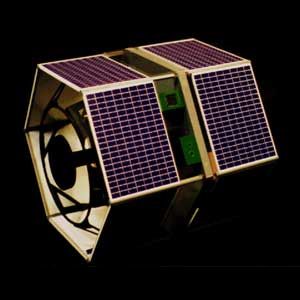SNOE (original) (raw)

Home - Search - Browse - Alphabetic Index: 0- 1- 2- 3- 4- 5- 6- 7- 8- 9
A- B- C- D- E- F- G- H- I- J- K- L- M- N- O- P- Q- R- S- T- U- V- W- X- Y- Z
SNOE

SNOE
Credit: Manufacturer Image
American technology satellite. Atmospheric science satellite operated by NASA, USA. Launched 1998.
Status: Operational 1998. First Launch: 1998-02-26. Last Launch: 1998-02-26. Number: 1 . Gross mass: 115 kg (253 lb).
NASA NSSDC Master Catalog Description
The Student Nitric Oxide Explorer (SNOE) project was the first satellite to be launched in NASA's Student Explorer Demonstration Initiative (STEDI) program. STEDI, managed for NASA by USRA, is a pilot program to demonstrate that high-quality space science can be carried out with small, low-cost (<$4.4 million) free-flying satellites on a time scale of two years from go-ahead to launch. The scientific objectives of the Student Nitric Oxide Explorer were a detailed study of variations in nitric oxide (NO) in the Earth thermosphere. NO is an important minor constituent that strongly affects the ion composition of the ionosphere and the thermal structure of the thermosphere. Specific objectives were to: (1) determine how variations in the solar soft X-radiation produce changes in the density of nitric oxide in the lower thermosphere; and, (2) determine how auroral activity produces increased nitric oxide in the polar regions.
The spacecraft was a compact hexagonal structure, approximately 0.9 m high and 1 m across it widest dimension, weighing a maximum of 100 kg. It was launched into a sun-synchronous circular orbit at 530-580 km altitude and 97.7 degrees inclination. It span at 5 rpm with the spin axis normal to the orbit plane and carried three instruments: an ultraviolet spectrometer to measure nitric oxide altitude profiles, a two-channel auroral photometer to measure auroral emissions beneath the spacecraft, and a five-channel solar soft X-ray photometer. SNOE also carried a GPS receiver for accurate orbit and attitude determination.
The SNOE spacecraft and its instrument complement were designed, built, and operated entirely at the Laboratory for Atmospheric and Space Physics (LASP) of the University of Colorado at Boulder.
SNOE re-entered the atmosphere on 2003-12-13 at 09:34Z +/- 6 minutes, descending over 2.9 deg S, 273.8 deg E, on orbit 32248, after 5 years and 290 days.
More at: SNOE.
Family: Earth, Sun synchronous orbit, Technology, Technology satellite. Country: USA. Launch Vehicles: Pegasus, Pegasus XL. Projects: STEDI. Launch Sites: Point Arguello WADZ. Agency: NASA Greenbelt, Colorado. Bibliography: 2, 276, 13112.
1998 February 26 - . 07:07 GMT - . Launch Site: Point Arguello. Launch Complex: Point Arguello WADZ. Launch Pad: Aircraft from Vandenberg.. Launch Platform: L-1011. LV Family: Pegasus. Launch Vehicle: Pegasus XL.
- SNOE - . Nation: USA. Agency: NASA Greenbelt. Manufacturer: Colorado. Program: STEDI. Class: Earth. Type: Seismology satellite. Spacecraft: SNOE. Decay Date: 2003-12-13 . USAF Sat Cat: 25233 . COSPAR: 1998-012A. Apogee: 581 km (361 mi). Perigee: 529 km (328 mi). Inclination: 97.70 deg. Period: 95.80 min.
SNOE, the Student Nitric Oxide Explorer. Small satellite built by the University of Colorado to measure the Nitric Oxide density as a function of altitude. First satellite in the STEDI (Student Explorer Demonstration Initiative) program. Air dropped in Point Arguello WADZ.
Home - Search - Browse - Alphabetic Index: 0- 1- 2- 3- 4- 5- 6- 7- 8- 9
A- B- C- D- E- F- G- H- I- J- K- L- M- N- O- P- Q- R- S- T- U- V- W- X- Y- Z
© 1997-2019 Mark Wade - Contact
© / Conditions for Use